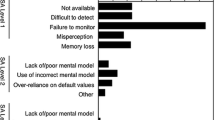Abstract
In this paragraph I will briefly give the background of the Aviation Safety Research Office at NASA Ames to provide the viewpoint from which I will make the comments that follow. The ASRO has been set up to define operating problems in today’s aviation system and to suggest solutions that can be implemented in a relatively short time; a typical time horizon is of the order of 2–5 years. Part of our organization administers the Aviation Safety Reporting System which solicits incident reports from users (controllers, pilots, etc.). This program is set up to identify situations requiring immediate action, e.g., a new operating quirk of a particular aircraft or class of aircraft; and to identify other problems through the accumulation of incident data, for example, the prevalence of altitude excursions. These data cannot be used to test hypotheses, but they may be used to formulate hypotheses which in turn may be examined by experimental programs. The research section of the ASRO consists of separately identified groups concerned with operational problems (crew procedures, communications, etc.), statistics, and, for want of a better name, behavioral research. The responsibilities of this latter group are to support research in the operational problems area with basic studies leading to models which can be used to predict behavior in the more complex setting. Current topics of interest are Allocation of control between man and automatic systems. Analyzing the effects of different crew procedures on system performance and system reliability.
Access this chapter
Tax calculation will be finalised at checkout
Purchases are for personal use only
Preview
Unable to display preview. Download preview PDF.
Similar content being viewed by others
References
Curry, R.E. and Gai, E.G., Detection of random process failures by human monitors,In Monitoring Behaviour and Supervisory Control ( Sheridannd Johannsen, Ed.) Plenum Press, 1976.
Curry, R.E., and Govindaraj, T., The human as a detector of changes in bandwidth and variance, Proc. 13th Annual Conf. on Manual Control, June 1977.
Gai, E.G. and Curry, R.E., A model of the human observer in failure detection tasks, IEEE Trans. Systems, Man and Cybernetics, February, 1976.
Gai, E.G. and Curry, R.E., Failure detection by pilots during automatic landing: models and experiments, AIAA Journ. of Aircraft, February, 1977.
Gartner, W., and Murphy, M., Pilot workload and fatigue; a critical survey of concepts and assessment techniques, NASA TN D-8365, November, 1976.
Kleinman, D.L., and Curry, R.E., Some control theoretic models of human operator display monitoring, IEEE Trans. Systems, Man and Cybernetics (in press).
Levison, W.H., A model for task interference, Proc. Sixth Annual Conf. on Manual Control, 1971.
Levison, W.H., A control-theory model for human decision-making, Proceedings of the Seventh Annual Conf. on Manual Control, NASA SP-281, 1971.
Sypker, D., Stackhouse, S., Khalafalla, A., and McLane, R. Development of techniques for measuring pilot workload,NASA CR-1888, 1971.
Wempe, T., and Baty, D., Human information processing rates during certain multiaxis tracking tasks with a concurrent auditory task, IEEE Trans. Man Machine Systems, Dec. 1968.
Wewerinke, P.H., Effort involved in single and two axis control systems, National Aerospace Laboratory NLR, Report NLR TR 75060 U, 1974.
Author information
Authors and Affiliations
Editor information
Editors and Affiliations
Rights and permissions
Copyright information
© 1979 Springer Science+Business Media New York
About this chapter
Cite this chapter
Curry, R.E. (1979). Mental Load in Monitoring Tasks. In: Moray, N. (eds) Mental Workload. NATO Conference Series, vol 8. Springer, Boston, MA. https://doi.org/10.1007/978-1-4757-0884-4_8
Download citation
DOI: https://doi.org/10.1007/978-1-4757-0884-4_8
Publisher Name: Springer, Boston, MA
Print ISBN: 978-1-4757-0886-8
Online ISBN: 978-1-4757-0884-4
eBook Packages: Springer Book Archive




